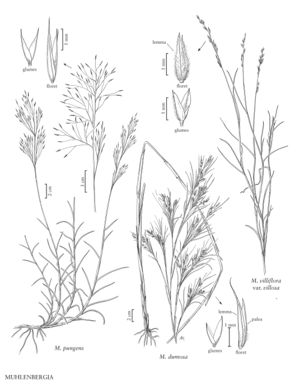Difference between revisions of "Muhlenbergia dumosa"
FNA>Volume Importer |
FNA>Volume Importer |
||
| Line 17: | Line 17: | ||
-->{{Treatment/Body | -->{{Treatment/Body | ||
|distribution=Ariz. | |distribution=Ariz. | ||
| − | |discussion=<p | + | |discussion=<p>Muhlenbergia dumosa grows on rocky slopes, canyon ledges, and cliffs, in areas protected from grazing animals in oak-pine and thorn-scrub forests and oak-gramma savannahs, at elevations of 600-1800 m, from Arizona to southern Mexico.</p><!-- |
--><p>The bladeless cauline leaves and abundant branching from the middle and upper nodes make 'Bamboo Muhly' a very apt English name. North American Indians used it, after boiling, for chest and bowel ailments. It is native from southern Arizona to southern Mexico, but is also grown as an ornamental in the southwestern United States.</p> | --><p>The bladeless cauline leaves and abundant branching from the middle and upper nodes make 'Bamboo Muhly' a very apt English name. North American Indians used it, after boiling, for chest and bowel ailments. It is native from southern Arizona to southern Mexico, but is also grown as an ornamental in the southwestern United States.</p> | ||
|tables= | |tables= | ||
| Line 34: | Line 34: | ||
|basionyms= | |basionyms= | ||
|family=Poaceae | |family=Poaceae | ||
| + | |illustrator=Linda A. Vorobik and Annaliese Miller | ||
|distribution=Ariz. | |distribution=Ariz. | ||
|reference=None | |reference=None | ||
| Line 39: | Line 40: | ||
|publication year= | |publication year= | ||
|special status= | |special status= | ||
| − | |source xml=https:// | + | |source xml=https://bibilujan@bitbucket.org/aafc-mbb/fna-data-curation.git/src/314eb390f968962f596ae85f506b4b3db8683b1b/coarse_grained_fna_xml/V25/V25_746.xml |
|subfamily=Poaceae subfam. Chloridoideae | |subfamily=Poaceae subfam. Chloridoideae | ||
|tribe=Poaceae tribe Cynodonteae | |tribe=Poaceae tribe Cynodonteae | ||
Revision as of 16:18, 30 October 2019
Plants perennial; rhizomatous, loosely cespitose. Culms 100-300 cm tall, 3-6 mm thick, erect or ascending, woody below, branching at the middle and upper nodes, branches numerous, fascicled, and spreading; internodes glabrous for most of their length, puberulent or glaucous below the nodes. Sheaths glabrous, enlarged and flattened basally, somewhat chartaceous; ligules 0.2-0.6 mm, membranous, truncate; blades of the branch leaves 1.2-8(12) cm long, 0.7-2.2 mm wide, flat or involute, glabrous abaxially, hirtellous adaxially; blades of the cauline leaves, particularly the lower cauline leaves, absent or greatly reduced. Panicles numerous, terminal on the main culms and the branches, 1-4 cm long, 0.3-1.4 cm wide, lax, inconspicuous; primary panicle branches appressed or loosely spreading up to 40° from the rachises; pedicels 0.1-1.5 mm. Spikelets 2.2-3.1 mm, green or purplish. Glumes subequal, 1-1.7 mm, glabrous, 1-veined, acute to acuminate, occasionally mucronate, mucros to 0.5 mm; lemmas 2.3-3.1 mm, lanceolate, appressed-pubescent on the calluses and lower portion of the margins, apices acuminate, awned, awns 1-5 mm, flexuous; paleas 2.3-3.1 mm, narrowly lanceolate, appressed-pubescent basally, acuminate; anthers 1.5-2 mm, purplish. Caryopses 1.2-1.6 mm, fusiform, reddish-brown. 2n = 40.
Discussion
Muhlenbergia dumosa grows on rocky slopes, canyon ledges, and cliffs, in areas protected from grazing animals in oak-pine and thorn-scrub forests and oak-gramma savannahs, at elevations of 600-1800 m, from Arizona to southern Mexico.
The bladeless cauline leaves and abundant branching from the middle and upper nodes make 'Bamboo Muhly' a very apt English name. North American Indians used it, after boiling, for chest and bowel ailments. It is native from southern Arizona to southern Mexico, but is also grown as an ornamental in the southwestern United States.
Selected References
None.
